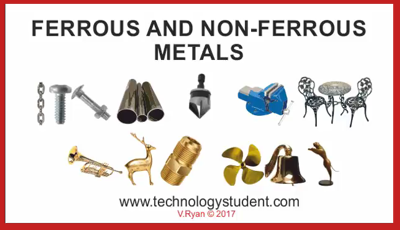Name Two Non Ferrous Metals
Non-ferrous metals tend to be softer and this characteristic makes them easier to mold bend and cut. Highly malleable with high electrical conductivity Lead.

Ferrous Non Ferrous Metals Differences Properties Asm Metal Recycling
Examples of non-ferrous metals use.

Name two non ferrous metals. Important non-ferrous metals include aluminium copper lead nickel tin titanium and zinc and alloys such as brass. For the average person lead may. Common non-ferrous metals include.
Nickel is not often used in its pure form and like copper and aluminum it is often alloyed with other elements to gain superior chemical and mechanical properties. In engineering terms a very special and important metal. Non-ferrous metals include aluminum copper lead zinc and tin as well as precious metals like gold and silver.
Copper is an easily distinguishable red metal that is soft and malleable. Their main advantage over ferrous materials is their malleability. Non-ferrous metals are also malleable and fairly lightweight which makes them perfect for anything that relies on speed andor flight.
Bronze and brass were the first metals cast by humanity in the Bronze Age and these copper alloys are still sand casted today. They also have no iron content giving them a higher resistance to rust and corrosion and making them ideal for gutters liquid pipes roofing and outdoor signs. It is a good conductor of heat and electricity making it ideal for use in motors sheet roofing and electrical wires.
The most widely used non-ferrous metals include copper aluminum zinc lead and tin. Copper is pretty widely spread in the industrial sphere. Even their alloys dont require iron content so those too count.
Iron and steel in all forms are viewed as ferrous metals while metals that dont constitute an iron component in them are termed as non-ferrous. These metals are generally magnetic in nature and have a high tensile strength. Nickel is known for its toughness ability to perform in high temperature and low temperature environments and corrosion resistance.
Non-Ferrous Metals List Copper. The term ferrous comes from the Latin word ferrum meaning containing iron. Thats primarily because most non-ferrous metals are pure elements.
Soft malleable low tensile strength metal often used to coat steel to prevent. Heavy soft malleable metal. There are more non-ferrous metals than ferrous metals on the Periodic Table of Elements.
While they can still rust or corrode its much less common and the process takes longer with these types of metals. Aluminum is a very common component about 8 percent of. The iron in ferrous metals causes corrosion problems over time.
May not be so useful in everyday application. Pig Iron is the first or basic form in which Iron is prepared as the metal from its ores. However in traditional sand casting foundries there are three noteworthy non-ferrous casting metals.
Nickel is another popular non-ferrous alloy. Metallic copper and its various alloys. Metals such as aluminum and copper make appearances around the home or business for gutter roofing and electrical work.
Ferrous Metals List Their Types and Properties. Alloy metals such as Duralumin which is composed of a combination of copper and manganese in a 41 ratio besides aluminum brass which is 35 zinc and 65 copper and Gliding metal an alloy of 15 zinc and 85 copper are some of the most prominent non-ferrous metal examples that are made by combining two or more other non-ferrous base metals. It is therefore impure and crude and requires.
Aluminium is a soft and ductile metal that has a low density and is resistant to corrosion. Examples of common non-ferrous metals include lead brass copper zinc tin gold silver and aluminumaluminum alloys. The lightweight quality of nonferrous metals like copper tin aluminum brass and lead has its advantages.
Non-ferrous metals have a long history in human civilization. Light in weight and malleable but strong a. Lightweight low-strength easily shaped Copper.
Copper for instance was discovered in 5000 BC at the end of the Stone Age. All sorts of specialized materials are cast. Copper is extracted from copper ores such as copper pyrites etc.
Nonferrous metals have had many uses throughout history with copper and bronze being heralded for advancing civilisation through from the stone age to 1700 BCE when people learnt to mine copper and tin to make bronze weapons. Non-ferrous metals appear frequently in industrial and residential settings. Silver copper and gold have been collected and used since ancient times as currency jewelry crucibles other holy objects weapons and architectural components.
Ferrous metals may contain small amounts of other elements such as carbon or nickel that are added in a specific proportion to achieve the desired. Ferrous metals are valued for their strength and durability while non-ferrous metals are chosen for their malleability corrosion and rust resistance and non-magnetic properties. Aluminum is mainly obtained from bauxite ore.
Its Types Properties Uses. Add the alloys brass copper and zinc and bronze. All these alloys share the same two basic non-ferrous qualities with their base metallic components indifference towards magnets and.
Examples of non-ferrous metals are. Low melting point low strength Tin.

Difference Between Ferrous And Non Ferrous Metals Metal Biz

Non Ferrous Metals List Science Struck

The Difference Between Ferrous And Non Ferrous Metal Metal Supermarkets Steel Aluminum Stainless Hot Rolled Cold Rolled Alloy Carbon Galvanized Brass Bronze Copper
